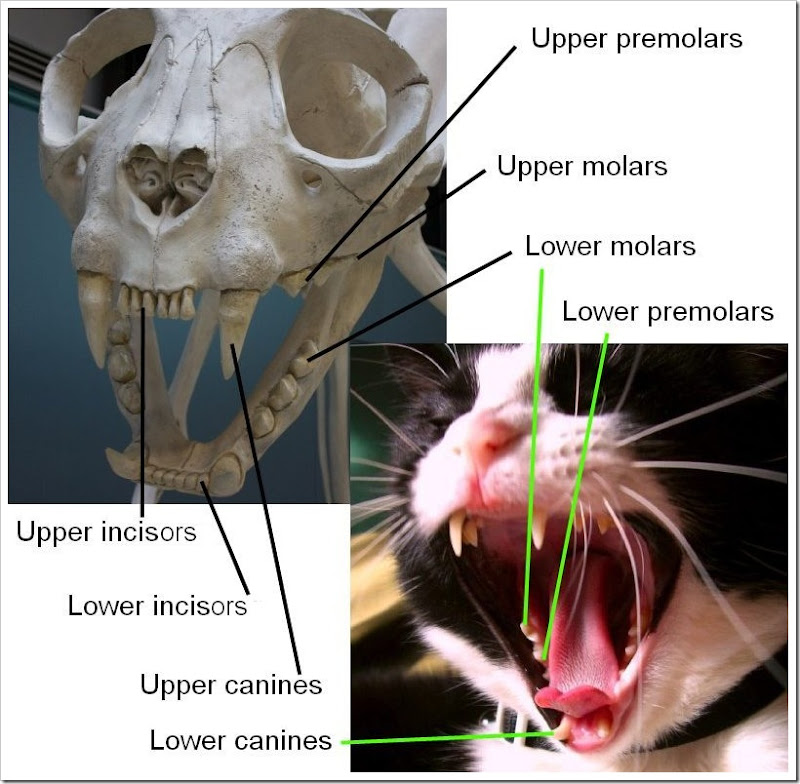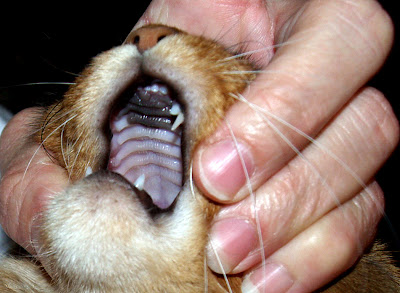This page simply sets out, as clearly as possible, information about cat’s teeth. We are all very aware of a cat’s teeth whether they belong to one of the big cats or one of our cat companions. They look impressive. Some people are a little frightened of them, I think. This may sometimes cause people to behave nervously with a cat, a mood which is picked up by the cat and may make it use those teeth!
Cats have shortened faces with less space for teeth. They have fewer teeth than other carnivores – usually 28 or 30, compared to 42 for bears and dogs.
The cat has two sets of teeth during its lifetime. Twenty-six deciduous teeth (baby or milk) begin to “erupt” at about 21 days of age1. With rare exceptions kittens are born without teeth4. They are fully grown by 5 to 6 weeks of age and the different types of teeth erupt at different times allowing age to be determined4(see below). At 4 months of age the thirty permanent teeth begin to show. These are complete by about 6 months of age. Cat teeth follow the general pattern that is found in most carnivores. A cat’s teeth tear flesh like serrated blades. A wild cat’s teeth are cleaned as they scrape over the bones of prey.
It is thought that dry cat food (dry kibble) can play a similar role for the domestic cat4 but others disagree6 describing it as “designer” food6. A majority of experts would agree that a properly prepared homemade raw dietwith ground bone is the answer to natural cat teeth health. Both the upper and lower jaws have:
- incisor teeth – function: grooming and tearing prey1 (and to grasp it as well3)
- canine teeth – function: grasping and killing prey
- premolar teeth – function: shearing, cutting up and chewing food
- molar teeth – function: shearing cutting up and chewing prey (or cat food if it is the domestic cat)
The picture below shows these teeth and the chart immediately below shows the number on the upper and lower jaws. When the jaw is closed the canine teeth interlock and the lower incisors rest just in front of the upper incisors. The molars are behind the incisors and premolars. The small incisors are for holding and nibbling. The canines are for stabbing and killing (breaking the vertebrae of prey).
The last upper molar on the top jaw and the lower molar together makes up the “carnassial teeth” (the large teeth found in many carnivorous mammals, used for shearing flesh and bone in a scissor or shear-like way5). These provide the shearing action that cuts food into pieces before swallowing. You can see your cat use these when he or she has to cut up a particularly tough piece of food. There are relatively few molars1.

Montage above: photos above by Jeremy Burgin (skelton) and thian_un (live cat). Both published under a creative commons license. Montage by MikeB.
Cat Teeth – Medical Information
Cat teeth can be chipped and broken or lost in fights with other cats. Dental problems in domestic cats are sometimes due to diet4. In fact, it is believed that dental and periodontal (gum) health is important to the rest of the body as bacteria from infected gums can spread to other organs of the body in the blood stream6. It is wise for a cat keeper to inspect their cat’s teeth regularly to check for basic health issues and if possible, to train your cat to accept brushing of teeth6. Veterinary cleaning under anesthetic might be required. Cleaning teeth without anesthetic is considered impractical6. Placing a cat under a general anesthetic carries a risk of injury or rarely death (1 in 100 or 1 in a 1,000 – ask you vet before requesting this procedure). See also:
- Bad Breath in Cats
- Cat Teeth Cleaning [link]
- Cat Teeth Neck Lesions

- Denal Gel For Cats
- Feline Gingivitis

There may be some soreness during teething4. This may affect apparent appetite. Sometimes baby teeth are “retained”. Usually, baby teeth are reabsorbed when the permanent teeth replace them. If not, then the permanent teeth are pushed out of alignment when they erupt causing a bad bite. When that happens the baby tooth that remains should be pulled out4. Sometimes cats have an abnormal number of teeth. If there are too few there are no health issues. If too many it may cause overlap and twisting of teeth requiring extraction. Incorrect bite: mostly inherited due to jaw growth or retained baby teeth. Overshot bite means that the upper jaw is longer than the lower. The undershot bite is the opposite. There is a third cause of incorrect bite: wry mouth caused by one side of the jaw growing faster than the other. The flat faced Persians (“ultra” Persian) tend to have more incorrect bites than other purebred cats.
Telling a Cat’s Age from their Teeth
In the wild the amount of wear on the cusps of the teeth can be a reliable guage of age. As domestic cats rarely use their teeth for grinding there is little wear but the general condition of the teeth and gums provide indications of age. For young cats accurate determinations of age are possible as the baby teeth erupt at different times4:
| Cat Teeth | Age they erupt |
| Incisors (baby) | 2 – 3 weeks |
| Canines (baby) | 3 – 4 weeks |
| Premolars (baby) | 3 – 6 weeks |
| Incisors (permanent) | 3 – 4 months |
| Canines (permanent) | 4 – 6 months |
| Premolars and molars | 4 – 6 months |
 The above picture shows the mouth of a kitten (Ivanhoe) aged just over 5 months (23 weeks). His permanent upper left canine has started breaking through and behind it the baby canine is still in place. A few days later it had fallen out by itself – photo by Finn Frode (Ivanhoe lives with Finn…) | |


I wonder if the crooked jaw is a result of the genetic deficiency which causes the folded ears? It is not strictly relevant. My gut feeling is that if your cat is healthy and eating well then the condition that you describe is not important. It appears to be an anatomical deformity which happen sometimes. The most famous anatomical deformity amongst all cats is the face of Grumpy Cat. When cat breeders get it wrong they sometimes breed cats with malformed jaws. This can be due to inbreeding. Like I say if your cat is healthy and eating well then I would suggest that you accept it. In any case there is little that can be done about it as far as I can see. I am not a veterinarian. Thanks for commenting, Julie. Best of luck.
My 8 mo old Scottish fold straight has a crooked lower jaw. One canine outside of his mouth. Has made a callous on his upper lip. His small teeth in the front not straight and looks like another one coming in Back of them . What should I do. He eats ok.
Hi Londa. I think if I was in your shoes I’d be asking the same question. He is a bit too aggressive for me. It looks like he has not learned the boundaries of play. I believe the rough play will subside. But it would be nice to try and train him to play more gently. I think it can be quite hard to achieve that.
Martin Stucki formerly of A1 Savannahs said that his kittens learned to moderate their play and understand their limits by the reaction of the recipient cat who’d complain. My cat has been too rough on me sometimes. I simply retaliate and play rougher on him. This stops him. I was my way of training him. But I am not sure it is the best way. My conclusion is (a) he has not learned the limits of play or (b) he is genuinely aggressive and this could be a territorial thing. I wrote a page about that recently.
https://pictures-of-cats.org/why-do-cats-leave-home.html
Best of luck.
I have an 18 month old male, Russian Blue (Marshall) that is very similar in size to Kyla’s kitty (Nov 2015). He’s not 20 pounds (yet!) but 15 pounds. We got him at five months old and know very little of his past. He was constantly, literally sinking his teeth into our hands/arms. After acquiring another, older/smaller/female cat (Lilly) we concluded that he was playing. She’s about five or six and can take him down, but sometimes she’s more passive and he gets the best of her. I worry about him harming her. He gets her by the neck. I haven’t found any damage to her skin but sometimes she loses a tuft of hair. Before he attacks her, he cries out in the same way he would before he attacked me. If I’m nearby, I try to deter him by saying, “Mashall, play nice” and sometimes he will back off. His cry is scary sounding! Should I be concerned?